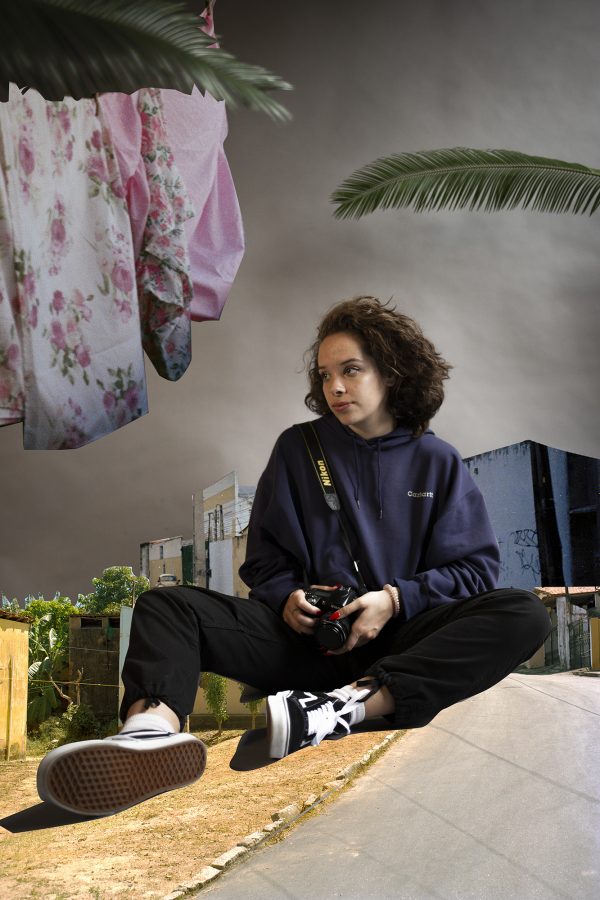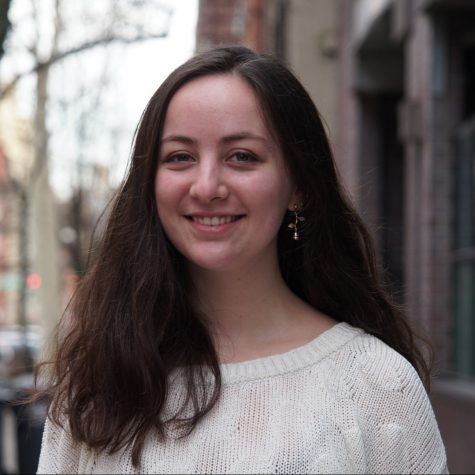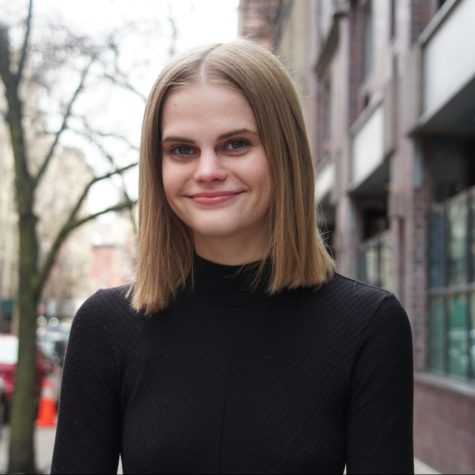
The Queen of Drag Photography
By Alina Patrick, Photo Editor
![]() hotography emerged in the 1800s and became the most democratic medium of the art world. It can be reproduced easily, performed by anyone willing to engage with their subject and allows for people of any background to become the subject matter. This ability to document a variety of subjects and use the medium to connect with them is the foundation of Nan Goldin’s work.
hotography emerged in the 1800s and became the most democratic medium of the art world. It can be reproduced easily, performed by anyone willing to engage with their subject and allows for people of any background to become the subject matter. This ability to document a variety of subjects and use the medium to connect with them is the foundation of Nan Goldin’s work.
Goldin was one of the first artists to take photography and use it to give dignified images to sexual minority groups in the U.S. She began her work in the 1970s, photographing drag queens in Boston and New York, and decades later, she worked in Paris, Berlin, Manila and Bangkok. Goldin’s photographs portray the glamour and elegance of the queens along with the highs and lows of their everyday lives.
In “The Other Side,” Goldin’s photography book published in 2000, she documents the lives of drag queens worldwide and demonstrates how she came to acquire such a deep understanding for the communities with which she spent so much time. In the introduction, she explains how the portraits “are not of people suffering gender dysphoria but rather expressing gender euphoria.”
Tisch Photography and Imaging junior Jay Arora noted that Goldin’s identity as a bisexual woman and her closeness to the subjects make the portraits more intimate.
“[In] each project, either the ‘The Other Side’ or ‘Sexual Dependency,’ her relationship with the subject drastically changes the image because she is documenting her life with the LGBT community instead of from afar,” Arora said.
Goldin does not shy away from taking raw, telling photographs, but her work does not reduce the experiences of drag queens to lives of isolation or sadness. Rather, Goldin’s work highlights the truly American experience of living outside of an accepted identity group and scraping together a full life.
The 1970s was a decade marked by change for the LGBTQ community, and Goldin documented it. The Stonewall Riots of 1969 brought the community out of the darkness, marking a political surge in LGBTQ activism. Charles Kaiser, author of “The Gay Metropolis: The Landmark History of Gay Life in America,” called the 1970s “a period of transformation for gays and lesbians, particularly those living in America’s coastal cities. At its core, that transformation was about visibility.” Visibility is exactly what Goldin’s work achieved, especially as she continued into the 1980s. During the AIDS crisis, she created a dignified and diverse image for the LGBTQ community.
The AIDS crisis of the 1980s hit the drag community hard. An already ostracized communit became further isolated and feared by American society. Goldin’s work complemented the activism that grew out of the LBGTQ community during this period by allowing for people to see a community they were constantly attempting to look away from. Furthermore, as a female photographer working in the documentary field, Goldin has become an inspiring figure for many women hoping to break into such a male-dominated industry.
“Women are put into a box where self-portraits are OK […] but perhaps it’s harder for a woman to be a documentarian and be taken seriously,” Tisch Photography and Imaging junior Katie McGowan said.
Goldin attempted to neither romanticize nor vilify the communities she documented. There is a great variety within the images she created, from glamorous shots of beautiful women out on the town to vulnerable, raw portraits of half-naked men alone in their homes. Images, such as “Christmas at The Other Side, Boston” (1972), showed a drag queen in pearls and a classy Audrey Hepburn-esque dress pretending to light a cigarette for the painting of a man hanging on the wall. This black and white image shows beauty and confidence as well as unabashed sexuality.
The photographer grew to respect the drag community because, as she explained in her book, “most people get scared when they can’t recognize others — by race, by age, and most of all, by gender. It takes nerve to walk down the street when you fall in the cracks.” Images, such as “Ivy in the Boston Garden, Boston” (1973), reinforce Goldin’s claim that she attempted to portray the drag queens how they presented themselves. In this case, as a glamorous classy woman. The image is also black and white, but with a softer focus, and shows Ivy gliding through a park, smoking a cigarette like a model or an actress from a 1960s film.
As Tisch Photography and Imaging senior Kodie Harris said, Goldin’s pictures “are, in the technical sense, not great photographs; they are blurry, badly lit and chaotically organized. What makes the photos great are the lives that they portray and the stories that are told within them.”
Not all portraits Goldin created depict glamour and fun. “Roommate with teacup, Boston” (1973) shows a more masculine figure with muscular arms and a flat chest leaning forward and staring seemingly at the floor. The soft lighting, introspective expression and view of the shirt falling off the roommate’s shoulder to reveal a lack of breasts shows a more intimate view of this subject’s personal life than the other images of parties and fashion.
In “The Other Side,” Goldin reflected that she “never saw them as men dressing as women, but as something entirely different — a third gender that made more sense than either of the two. I accepted them as they saw themselves; I had no desire to unmask them with my camera.” Portraits, such as “Roommate with teacup, Boston,” reveal that view of a third gender and the honesty Goldin was attempting to display. Yet Goldin chose not to include simply reflective or even sad moments in her photographs. She displayed a full life of euphoria and contemplation alike, so as not to reduce the community to a stereotype in either direction.
Goldin lived and worked in the LGBTQ community before the U.S. took pride in it. To her, “it is not a detachment to take a picture. It’s a way of touching somebody — it’s a caress […] I think you can actually give people access to their soul.” The close personal connection she feels toward her subjects is evident not only in the access she was able to gain to their working lives, homes and sexual experiences, but also in the rare moments of introspection photographers can be lucky enough to witness in a subject’s gaze.
Her determination to grant this community living between identity groups a dignified image for the time was monumental and a true representation of the American Dream.
Email Alina Patrick at [email protected]. A version of this article appears in the Thursday, April 4, 2019, print edition on Page 9. Read more from Washington Square News’ “Arts Issue Spring 2019.”

























































































































































